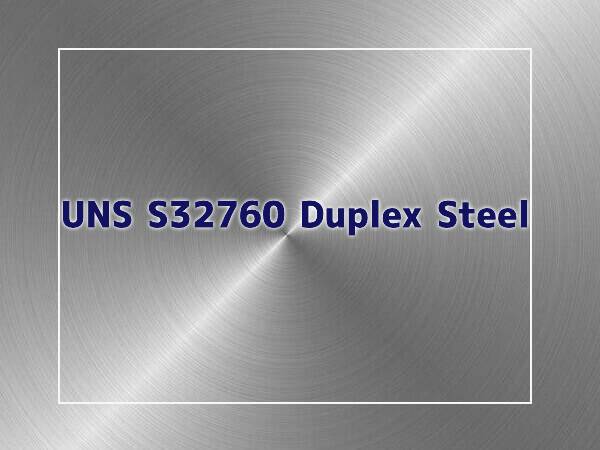
UNS S32760 is a super duplex grade with a ferritic-austenitic microstructure designed for service in aggressive chloride-containing environments and has additions of W and Cu compared to UNS S32750. It has good resistance to localized corrosion and stress corrosion cracking in combination, with high mechanical strength. The super duplex microstructure has the high strength of the ferritic grades whilst retaining the corrosion resistance of the austenitic grades. UNS S32760 also has outstanding resistance against sulphide-stress corrosion cracking in sour-gas environments, and high impact strength, even when welded, UNS S32760 presents only slightly lower impact strength.
UNS S32760 Chemical Composition
The chemical composition of S32760 contains 24-26% chromium, 6-8% nickel, and 3-4% molybdenum as well as copper, tungsten, and nitrogen alloy, UNS S32760 is a highly alloyed super duplex stainless steel with high PREN for use in aggressive environments.
| Cr | Ni | Mo | W | Cu | C | Mn | N | Si | P | S | Fe |
|---|---|---|---|---|---|---|---|---|---|---|---|
| 24.00-26.00 | 6.00-8.00 | 3.00-4.00 | 0.50-1.00 | 0.50-1.00 | 0.03 | 1.00 | 0.20- 0.30 | 1.00 | 0.030 | 0.010 | Bal |
UNS S32760 Mechanical Properties
| Tensile Strength, Mpa (Ksi), Min | Yield Strength, MPa (Ksi), Min | Elongation, %, Min |
|---|---|---|
| 750 (108) | 550 (80) | 25 |
UNS S32760 Physical Properties
| Physical Properties | Data |
|---|---|
| Density (Kg/M3) | 7810 |
| Magnetic Permeability (20°C) | 33 |
| Young’s Modulus (KN/Mm2) | 199 |
| Specific Electrical Resistance, 20°C (ΜΩ.M) | 0.8 |
| Mean Coefficient Of Thermal Expansion, 20-300°C (M/M/OC) | 11.1 X 10-6 |
| Specific Heat, 20°C (J/Kg.K) | 475 |
| Thermal Conductivity, 20°C (W/M.K) | 14.2 |
| Fracture Toughness, KQ (MPa/M2) | 98 |
UNS S32760 Equivalent
- EN 1.4501
- Grade F55
- (Zeron 100)
Forms
- ASTM A240 plate
- ASTM A479 UNS S32760 shapes
- ASTM A790 UNS S32760 pipe
- ASTM A182 F55 fitting
- ASTM A276 UNS S32760 bar
- ASTM A760 UNS S32760 Corrugated Steel Pipe
- ASTM A815 UNS S32760 pipe fitting
UNS S32760 Properties
- Guaranteed corrosion performance (PREn ≥ 40)
- Excellent corrosion resistance in mineral acids such as hydrochloric and sulfuric
- High resistance to pitting and crevice corrosion
- Excellent resistance to stress corrosion cracking in both chloride and sour environments
- High resistance to erosion corrosion and corrosion fatigue
- Excellent mechanical properties
- Possibility for weight reduction over austenitic, standard duplex and nickel base alloys
- Good weldability
Corrosion Resistance
Alloy S32760 provides excellent corrosion resistance and strength properties. In comparison with UNS S32205, SUS 329J3L, and SUS 329J4L (NAS 64), it offers superior localized corrosion resistance and thus is suitable for use in chemical plants, seawater desalination plants, and similar severe environments.
Welding
Various welding methods are applicable in the same manner as with the standard austenitic stainless steels, including shielded metal arc welding, TIG welding, and plasma welding. The use of welding electrodes for UNS S32760 is recommended. Preheating and post-heating are not necessary. In welding, the interpass temperature should be no more than 100℃ to prevent the formation of intermetallic compounds.
Heat Treatment
Duplex stainless steel cannot be hardened by heat treatment. They can however be work-hardened.
Solution treatment or annealing can be done by rapid cooling after heating to around 1100°C.
Disadvantages of UNS S32760
Firstly, the higher price of UNS S32760 is due to its exceptional properties such as superior corrosion resistance and high strength. This material is typically costly and not suitable for large-scale use in cost-sensitive applications.
Secondly, UNS S32760 contains a variety of alloying elements, such as molybdenum, which may lead to an elemental imbalance if its alloying composition is not reasonably adjusted, thus reducing its corrosion resistance. Therefore, special attention needs to be paid to the balance of alloying elements during use.
Finally, UNS S32760 is susceptible to localized corrosion in chloride-containing environments. Although it performs well in most environments, special care needs to be taken when using it in chloride environments to avoid localized corrosion.
Related References
- ASTM A789, ASME SA789 – Seamless and Welded Ferritic/Austenitic Stainless Steel Tubing for General Service
- ASTM A790, ASME SA790 – General Requirements for alloy and Stainless Steel Pipe
- Related References
- ASTM A240/ASME SB240, Standard Specification for Chromium and Chromium-Nickel Stainless Steel Plate, Sheet, and Strip for Pressure Vessels and for General Applications
- ASTM A480, Standard Specification for General Requirements for Flat-Rolled Stainless and Heat-Resisting Steel Plate, Sheet, and Strip
- EN 10088-2, Stainless steels. Technical delivery conditions for sheet/plate and strip of corrosion-resisting steels for general purposes
- EN 10088-3, Stainless steels. Technical delivery conditions for semi-finished products, bars, rods, wire, sections and bright products of corrosion-resisting steels for general purposes
- EN 10088-4, Stainless steels. Technical delivery conditions for sheet/plate and strip of corrosion-resisting steels for construction purposes
- EN 10088-5, Stainless steels. Technical delivery conditions for bars, rods, wire, sections and bright products of corrosion-resisting steels for construction purposes
- ASTM A249, Standard Specification for Welded Austenitic Steel Boiler, Superheater, Heat-Exchanger, and Condenser Tubes
- ASTM A213, Standard Specification for Seamless Ferritic and Austenitic Alloy-Steel Boiler, Superheater, and Heat-Exchanger Tubes
- ASTM A312, Standard Specification for Seamless, Welded, and Heavily Cold Worked Austenitic Stainless Steel Pipes
- ASTM A182/A182M, Standard Specification for Forged or Rolled Alloy and Stainless Steel Pipe Flanges, Forged Fittings, and Valves and Parts for High-Temperature Service
- ASTM A815/A815M, Standard Specification for Wrought Ferritic, Ferritic/Austenitic, and Martensitic Stainless Steel Piping Fittings
